
Weed it & Reap: Toledo duo go native
7/16/2014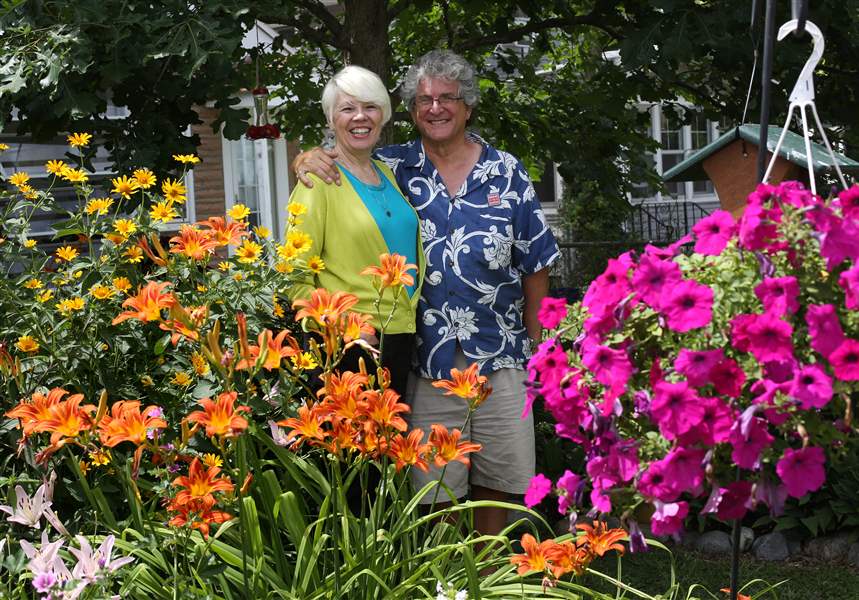
The Point Place home of Sue Carter and Mike Ferner features a wide array of native plants. Their property, which overlooks Lake Erie, is no more than 27 feet wide.
The Blade/Katie Rausch
Buy This Image
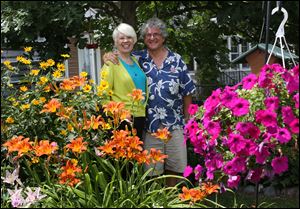
The Point Place home of Sue Carter and Mike Ferner features a wide array of native plants. Their property, which overlooks Lake Erie, is no more than 27 feet wide.
Sue Carter and Mike Ferner live in an 1,100-square-foot cottage built in 1922 when Toledoans took buses out to summer homes on Maumee Bay in Point Place, such as theirs.
Their slice of heaven runs up to the shore, a 27-foor-wide sliver, but enough for a swing-for-two on grass flanked by two rock-lined flower beds.
Sue graduated from DeVilbiss High School and the University of Toledo. She has counseled and advocated for people who have HIV/AIDS for decades.
PHOTO GALLERY: Click here to view slideshow.
Mike joined the U.S. Navy after graduating from St. John’s Jesuit High School, working in hospitals stateside, caring for people wounded in the Vietnam War. “I had a head full of John Wayne movies,” he explains. In his third year of service, he was granted conscientious objector status and discharged.
He‘s retired from decades of political activism that included two two-year terms as a Toledo City Council member (elected in 1989 and 1991) and a 1993 mayoral run as an independent against Carty Finkbeiner that was unsuccessful.
He worked for Veterans for Peace (national president and president of the board), the Farm Labor Organizing Committee, as a union organizer, and for the Program on Corporations, Law, and Democracy.
In 2006, he published Inside the Red Zone: A Veteran for Peace Reports from Iraq, recounting three months he spent in that country before and after the U.S. invasion.
Enjoying Cocktail Hour with Mimi (one of two stray cats) in the afternoon overlooking the bay, they’ve come to love birds.
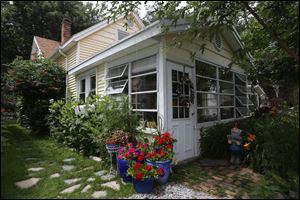
The Point Place home of Sue Carter and Mike Ferner.
About five years ago, Mike began learning about the benefits of native plants. “Until then, I didn’t realize that almost all the plants you see around people’s homes don’t do anything for the pollinators. And if pollinators don’t get anything out of it, that means the birds who eat the insects don’t get anything out of it. There are bird species you just won’t have around unless you have the insects they eat. There’s a tremendous interconnectedness,” he said.
When they saw non-native phragmites (the tall, feathery reed often seen along the sides of freeways) growing just off shore, they decided to uproot it, but it put a mighty fight. At its base, phragmites (pronounced frag-My-tees) sends out horizontal runners that put down deep roots. They noticed water birds couldn’t get to shore. Unlike the cattails they often overpower, phragmites usually forms large, dense stands that provide little value for wildlife and reduce the diversity of both plants and critters.
After pulling, digging, and researching, Sue determined that chemical warfare was the sole option to eliminate this grass. She waited until a fall day when the water blew out, slogged out, and sprayed them with Roundup. She later cut down the dead reeds. Mike collected cattail heads from a ditch and threw them in the water. The following spring, they were delighted to see the cattail seeds had sprouted. They still fight the hardy phragmites.
Sue Carter, social worker for the Ryan White HIV/AIDS program at the University of Toledo Medical College, formerly known as the Medical College of Ohio, and Mike Ferner, retired, living in Point Place.
Garden dimensions: The lot is 27-feet-wide by 201-feet deep, with gardens all around. The grassy front faces Maumee Bay. A new bed on the small rise above the shoreline is 12-by-25-feet; it’s heavy clay soil on top of rubble from a long-ago driveway. We amended the soil by putting layers of cardboard, newspapers, topsoil, and hardwood mulch.
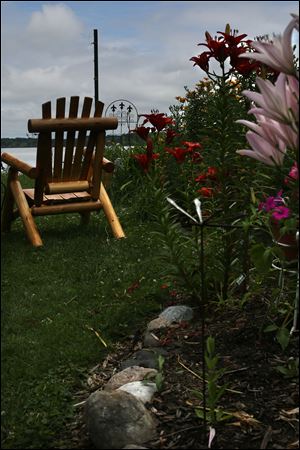
Asian lilies grow in a variety of colors in the yard.
When and how did you start gardening? Mike: As the third of eight kids, in my mother’s huge vegetable garden in Berkey. It was an economic necessity. My mother’s foster parents were Italian and we’d can bushels of tomatoes. I would stand at that Foley food grinder for hours. From fifth grade on, I worked on nearby farms hoeing sugar beets and soybeans for 75-cents an hour. Sue: I started gardening as an adult when I found out how rewarding it was. It is a way to slow down and enjoy life. It was so cathartic. When you’re a social worker, the successes aren’t immediate, but when you weed a bed, you have a sense of completion.
What do you grow? Native wildflowers, native iris, native lilies (turk’s cap), lanceleaf coreopsis, many varieties of Oriental and Asiatic lilies, western spiderwort, bergamot, prairie dropseed, some daffodils, tulips, our favorite herbs in pots, tomatoes, greens. Mike: For the new bed, a prairie nursery, I bought native plants that can grow in poor, stony soil. In front of that I planted 60 plugs of buffalo grass which is drought resistant and compatible with native flowers. It gets about three inches high. I won’t have to mow it.
We’ve lost several trees, including a big ash and an old cherry, and all the trees we have now were planted by squirrels in the right places -- red bud, burr oak, mulberry. A silver maple seed blew in and took hold.
Favorite plants: Mike: Cup plant, asters. Sue: I feel I should say mea culpa because, my favorites are all the gorgeous Asiatic and Oriental lilies that are not native.
Give us a tip: Mike: Gardening is like the Mud Hens, there’s always next year. Sue: I have a really intense job that I love. I had to work on balance and equilibrium. I had to learn to sit down, be quiet, observe, listen. It makes you sane. It’ll save your life.
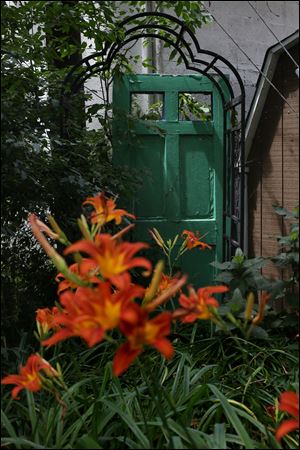
Ms. Carter paints doors and uses them to decorate her backyard garden. Pictured at front are orange Day Lilies.
Hours spent gardening per week? Mike: April through October about 25-30 hours. Sue: Because we like to, not because we have to. Mike: And a couple hours a day just sitting, observing and enjoying. In earlier years we discovered we rarely went out to the garden unless it was to work on it. Now we’re sure to take time just to sit and appreciate the garden, the birds, and the lake. It’s bliss!
Annual expense: This year about $1,000 because we bought so many new plants for the new bed. Each year we buy no more than $500. We’ve gotten most of our natives from Eileen Metress (of West Toledo).
Challenges: Getting the proper nutrient levels in the soil for vegetables. And we don’t have enough room for all the native plants we’d like. And invasive critters and plants.
And here’s a challenge for the city of Toledo: follow the lead of the Toledo Zoo and plant natives in parks, boulevards, and along roadways. Planting annuals is costly in wages, water, and upkeep; provides no benefit to bees or butterflies, and has to be repeated, well, annually. What a waste! Toledo could become known for a massive turn to native-plant beauty, fueled by the knowledge and energy of local enthusiasts. Besides, marigolds look really ditsy and tell visitors we’re stodgy old farts!
We’re proud of: Sue: Each year providing a little more variety, a few more natives that provide food and habitat for the birds, bees, butterflies, and other winged creatures. Mike: Watching Sue go from novice to an excellent gardener. Best of all, she likes to weed.
What do you get out of gardening? Peace of mind from the activity; much pleasure seeing the additional wildlife the garden attracts; satisfaction that we’re doing our tiny little bit to heal the planet.